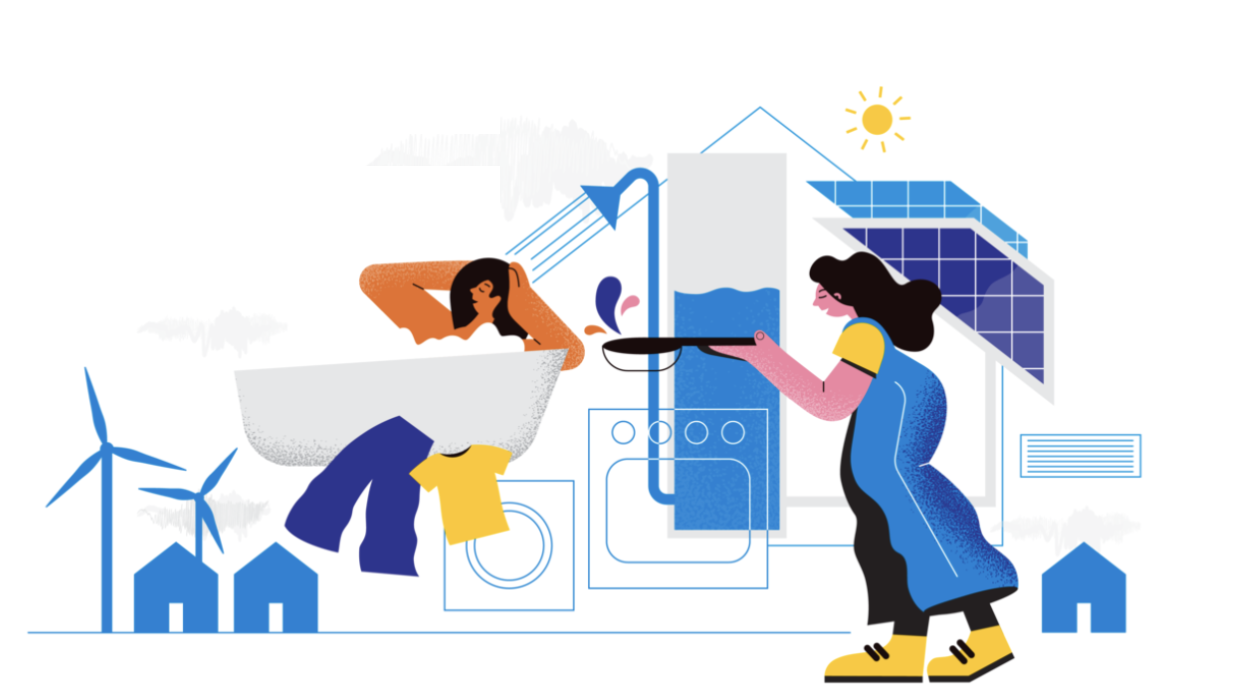
Image from pollutionfreeco.com
by Jasmine Vazin
What is a healthy home?
Our homes are the buildings we live in, but in the broader sense, our home is also the earth which provides for us. Our health is inextricably linked to the health of our planet, and what is best for the planet is inherently what is best for our health as well. To me, a healthy home first and foremost means structures that protect our health, as well as the health of our planet in the face of climate change.
Buildings and homes typically burn gas and propane in order to power water heaters, space heaters, stoves, and more. Most of us don’t think that we have fossil fuels in our homes, but each time our furnace kicks on or we cook something on our stove we are burning fossil fuels and significantly harming our health. Gas appliances release dangerous toxins—including carbon monoxide, nitrogen dioxide (NO2), particulate matter, and formaldehyde—inside into the air we breathe. Air quality inside homes, where people spend 90% of their time, is often so unhealthy that it wouldn’t meet outdoor air quality standards—but unlike outdoor air quality, indoor air is not regulated. This has led to buildings being the most deadly source of air pollution in the U.S.-- linked to a greater number of premature deaths in than either the power generation or transportation sectors. In 2018, an astounding 28,200 premature deaths in the U.S. were linked to toxic pollution from buildings.
The impacts of indoor air quality are significant on the body. The chemicals that are released when gas is burned using appliances like our stoves can cause full body effects; from strokes, to heart failure, lung cancer, and birth defects. Chronic exposure to these pollutants over many years increases the risk of side effects. Children are particularly vulnerable to polluted air. Kids growing up in a household with a gas stove have a 42% higher risk of experiencing asthma symptoms. Children are more susceptible to health impacts from environmental pollutants, and are thus more likely across the board to suffer from impacts of gas appliance use.
How can we clean the air in our homes?
First and foremost, always use your vent hood when cooking with a gas stove, and check your gas appliances for leaks to ensure you are limiting your families exposure to harmful pollutants. As you purchase new appliances, or as our cities build new houses, choosing electric appliances from the beginning will automatically provide cleaner indoor air quality compared to choosing gas powered alternatives. Electrified technologies are more advanced than ever before and offer a wide range of benefits:
-
Induction stoves can boil water twice as fast as a gas cooktop, and offer more precision with temperature control- and my favorite thing about them is how easy they are to clean!
-
Heat pumps are an all in one solution for temperature control in homes, these systems are 200-300% more efficient than gas powered heating systems, AND heat pumps offer heating and cooling in the same appliance.
-
Electric water heaters are cheaper than gas powered options and are more efficient with both power and water.
When it comes to costs electrified appliance options also offer economic benefits:
-
Building homes with clean electric appliances that can run on renewable energy is often less expensive than building homes with polluting fossil fuel appliances. Developers building all-electric save on the cost of extending gas service to a new home - which carries a median price tag of nearly $9,000, according to the Rocky Mountain Institute.
-
Electrified appliances also save consumers money, as they reduce homeowner costs over the lifetime of the appliance compared to gas alternatives
-
And, having cleaner air in your home automatically protects your wallet by preventing the incurrence of medical costs. Asthma medical costs were estimated to cost Nevadens around 1 billion in 2012 alone.
-
On a state level, By phasing out gas in homes and buildings, the states can invest more financial resources into maintaining and expanding their electricity grid and renewable energy resources—rather than pouring billions into maintaining polluting gas pipelines.
Why does this matter in Nevada?
As fossil fuels, the use of gas and propane to power our homes contributes to global climate change. Everytime we make breakfast or turn on the heat, we release warming pollutants in the atmosphere if we use gas appliances. After the summer we have had in Nevada-- with extreme heat waves, endless droughts, and blazing wildfires, our state cannot afford to be inactive when it comes to implementing climate solutions, and that includes the building sector.
Burning fossil fuels in the buildings sector in Nevada produced 9 million metric tons (MMT) of carbon dioxide equivalent (CO2e) in 2018. Which is about the annual emissions of 2 coal fired power plants, or the emissions from 2 million cars a year. With the recent UN Intergovernmental Panel On Climate Change’s 2021 report stating that we are in a state of emergency when it comes to climate, our job as environmental activists is to call on our electeds and decision makers to reduce emissions from all sectors as quickly as possible. Buildings are an important piece of the emissions reduction work that we have to do in Nevada, and this campaign is more important than ever to ensure our long term stability well into the future.
How to Get Involved
Our campaign and the new healthy homes team we recently launched at the Toiyabe Chapter are going to be working on this problem and brainstorming local solutions. You can join our team every other Monday at 2PM to get involved in this work- RSVP HERE!